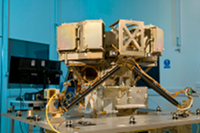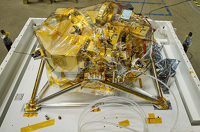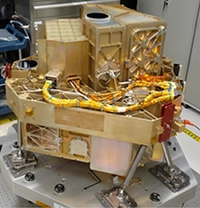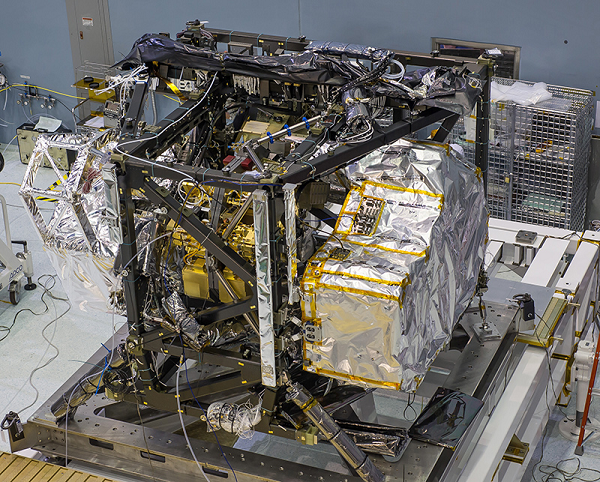The JWST instrument suite
JWST will carry four science instruments:
| NIRSpec Near-Infrared Spectrograph, provided by ESA with some elements provided by NASA's Goddard Space Flight Center. A wide field (3.4' × 3.6') multi-object near- infrared spectrometer covering wavelengths 0.6 µm - 5 µm at spectral resolutions of R~100, R~1000 and R~2700. NIRSpec will enable large spectroscopic surveys of astronomical objects like stars or distant galaxies, made possible by the powerful Multi-Object Spectroscopy (MOS) mode that is capable of obtaining spectra of up to nearly 200 objects simultaneously. |

NIRSpec. Credit: Airbus Defence and Space GmbH |
| MIRI Mid-Infrared Instrument, provided by a partnership composed of ESA, a consortium of nationally funded European institutes, NASA's Jet Propulsion Laboratory, and NASA's Goddard Space Flight Center (GSFC). A combined mid-infrared camera (1.3' × 1.7') and spectrograph (R~100 and R~3000) covering wavelengths from 5 µm to 28.3 µm. It also includes a coronagraph. MIRI will support the whole range of JWST’s science goals, from observing our own Solar System and other planetary systems to the study of the early Universe. It is the only instrument capable of mid-infrared observations and as such is cooled to -266 degrees Celsius, which is more than 30 degrees cooler than the other instruments in the JWST observatory, achieved with a cryocooler. |

MIRI. Credit: STFC/RAL Space |
| NIRCam Near-Infrared Camera, provided by the University of Arizona. A two-channel wide field (2.2' × 4.4') near-infrared camera covering wavelengths 0.6 µm - 5 µm with a large selection of filters. NIRCam will also provide key measurements for the in-orbit adjustment of the shape of JWST's primary mirror segments. It is the observatory's primary camera that will acquire some of the deepest near-infrared images ever obtained and detect light from the first stars and galaxies. NIRCam also has coronagraphic and spectroscopic capabilities that can be used to characterise exoplanets and planetary systems. |

NIRCam. Credit: NASA/Chris Gunn |
| FGS/NIRISS Fine Guidance System/Near-InfraRed Imager and Slitless Spectrograph, provided by the Canadian Space Agency. NIRISS comprises a wide-field (2.2' × 2.2') camera that will be usable in parallel with NIRCam's main camera to provide additional imaging capabilities, a slitless spectrograph, and a spectroscopic mode that is specially designed for exoplanet characterisation using transit spectroscopy for studying the chemical composition of an exoplanet's atmosphere. The instrument's accompanying Fine Guidance Sensor (FGS) will guide JWST to point precisely so that it can obtain high-resolution images and spectra. |

FGS/NIRISS. Credit: COM DEV Canada |
The four instruments are housed within the JWST payload module called the Integrated Science Instrument Module (ISIM).
 |
|
This photograph shows the JWST's Integrated Science Instrument Module (ISIM – the black structure) after the integration of all four of JWST's instruments. Credit: NASA/Chris Gunn |
Last Update: 28 May 2021





